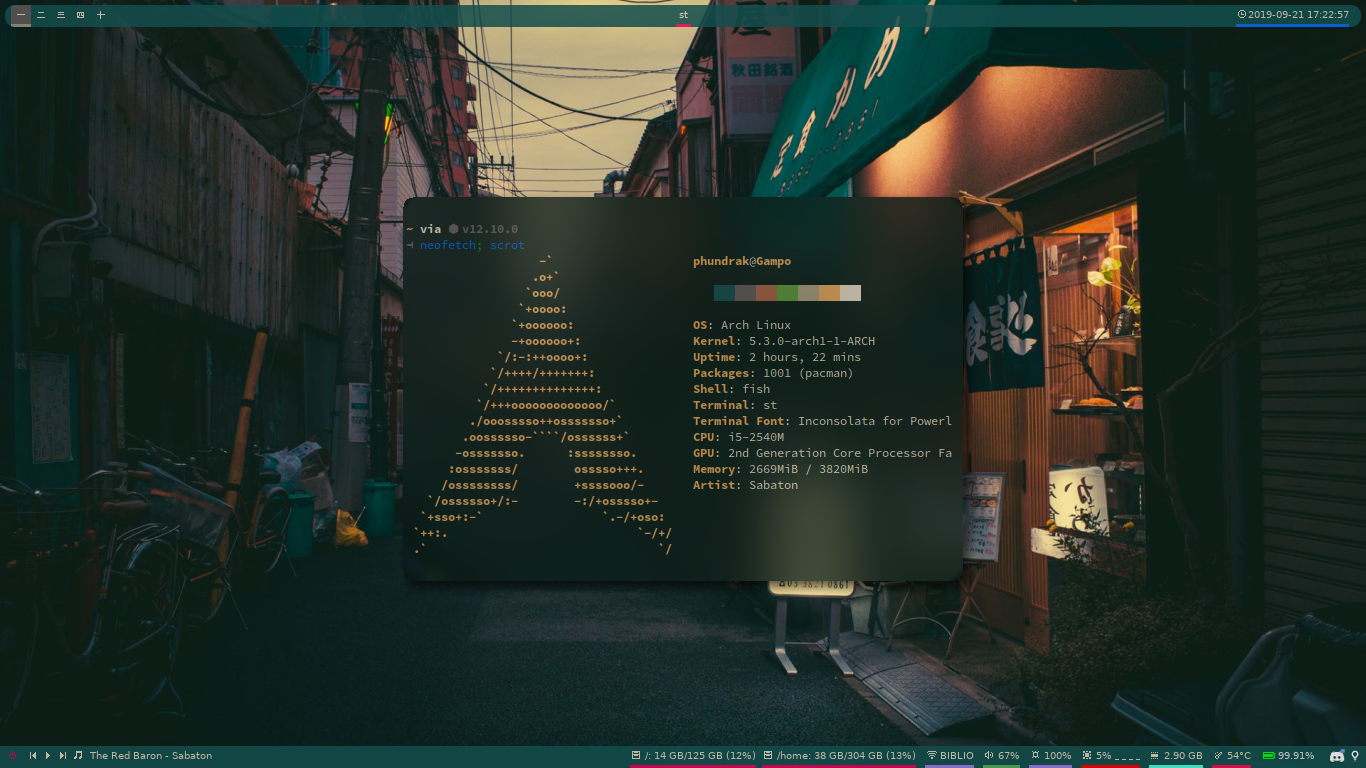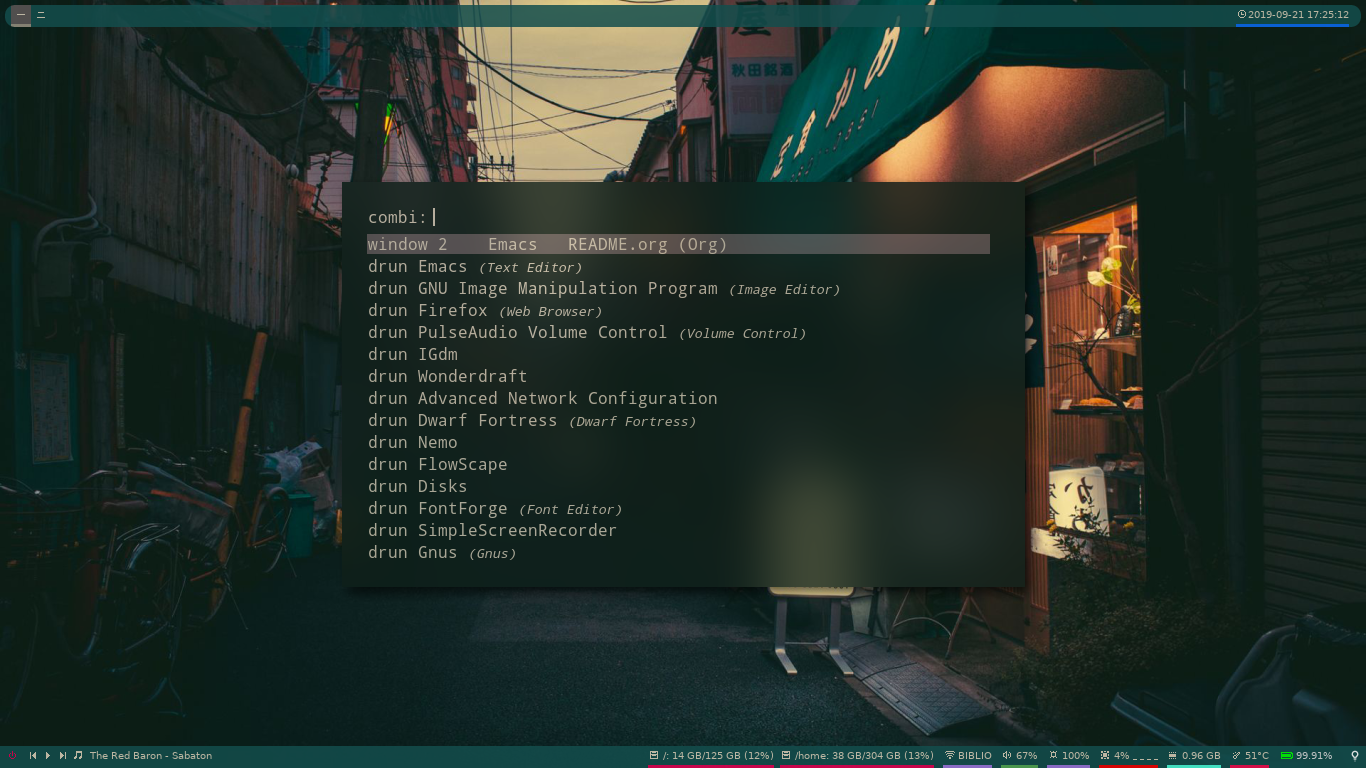16 KiB
Phundrak’s dotfiles
Presentation
This is my collection of dotfiles for my daily GNU/Linux environment, tweaked to my liking. If you wish to get the same setup as mine, follow the instructions below.
As you can see, I personally use fish as my shell of choice, and Emacs using Spacemacs (still with Emacs keybinding) as my main text editor.
I also use Resloved’s fork of i3-gaps with two polybar bars and Tryone144’s fork of Compton. The colors scheme for rofi, Emacs and polybar are chosen from the wallpapers using pywal.
Screenshots



Features
- Emacs configuration perfectly tailored for my own use
- Beautiful and comfy i3 and polybar configuration
- And enough information below to get basically the same distro install as I have on my main computer and my travel laptop.
Most of the org files you will find in this repos are the actual source code
of much of my config files. For instance, the bootstrap found in
installation.org exports almost all of its code snippets to
.config/yadm/bootstrap thanks to M-x org-babel-tangle from within Emacs.
Below I will also present and comment some of my short config files which do
not deserve to have a full org file dedicated to them.
Custom scripts in PATH
I have written some scripts that help me daily accomplish some simple tasks, like mounting and unmounting a drive or Android device, an emoji picker, a utility to set up my Wacom tablet, and so on. You can find them stored in .local/bin along with their detailed explanation in the README placed in the same folder —which is actually their source code once the org-mode file gets tangled.
Emacs configuration
Emacs is my main text editor, which I use for almost everything. Because, you know…
Emacs is a great operating system, it just lacks a good text editor.
You can find my Emacs config, based on Spacemacs, in my .spacemacs file, and my user configuration in my spacemacs.org file.
Email signature
This file gets inserted automatically at the end of my emails.
Lucien “Phundrak” Cartier-Tilet
https://phundrak.com (Français)
https://en.phundrak.com (English)
Pensez à notre planète, avez-vous vraiment besoin d’imprimer ce courriel ?
Please mind our planet, do you really need to print this email?Fish configuration with useful abbreviations
You can also find in .config/fish my Fish shell configuration, which contains my usual abbreviations.
Global gitignore
Sometimes, there are some lines that always reappear in gitignores. So, instead of always adding them, let git now that some elements are to be ignored by default, hence the ~/.gitignore_global file. First, we don’t want nano’s backup files.
~*
And output binaries generated by gcc and the likes aren’t welcome either.
,*.outi3 configuration
The i3 configuration is detailed in its corresponding README which you can find at .config/i3/README.org.
Nano
Although it is a very simple piece of software, nano does offer some customization. Here is mine.
Configuration
When soft line wrapping is enabled, make it wrap lines at blank characters (tabs and spaces) instead of always at the edge of the screen.
set atblanksAutomatically indent a newly created line to the same number of tabs and/or spaces as the previous line (or as the next line if the previous line is the beginning of a paragraph).
set autoindent
When saving a file, create a backup file by adding a tilde (~) to the
file's name. And make and keep not just one backup file, but make and keep a
uniquely numbered one every time a file is saved — when backups are enabled
with set backup or --backup or -B. The uniquely numbered files are
stored in the directory ~/.cache/nano/backups/.
set backup
set backupdir /home/phundrak/.cache/nano/backups/
Use bold instead of reverse video for the title bar, status bar, key combos,
function tags, line numbers, and selected text. This can be overridden by
setting the options titlecolor, statuscolor, keycolor,
functioncolor, numbercolor, and selectedcolor.
set boldtextDo case-unsensitive searches by default.
unset casesensitive
Constantly display the cursor position in the status bar. This overrides the
option quickblank.
set constantshowDisplay line numbers to the left of the text area.
set linenumbers
Do regular-expression searches by default. Regular expressions in nano are
of the extended type (ERE).
set regexpMake the Home key smarter. When Home is pressed anywhere but at the very beginning of non-whitespace characters on a line, the cursor will jump to that beginning (either forwards or backwards). If the cursor is already at that position, it will jump to the true beginning of the line.
set smarthomeEnable soft line wrapping for easier viewing of very long lines.
set softwrapUse a tab size of a certain amount of columns. The value of number must be greater than 0. The default value is 8.
set tabsize 2Convert typed tabs to spaces. Sue me.
set tabstospacesRemove trailing whitespace from wrapped lines when automatic hard-wrapping occurs or when text is justified.
set trimblanks
Save a file by default in Unix format. This overrides nano's default
behavior of saving a file in the format that it had. (This option has no
effect when you also use set noconvert.)
set unixIncluded configuration file
Nano gives the opportunity to include some files located elsewhere. This is
why I added this repo as a submodule of my dotfiles so I can access a lot of
them at the same time. Since the submodule is cloned in ~/.config/nanorc,
we can add only one line to include all of the .nanorc files.
include ~/.config/nanorc/*.nanorcRustfmt
In my .rustfmt.toml, you can find some custom rules on how my Rust code should be formatted.
First, we are using the 2018 edition of Rust.
edition = "2018"The maximum length of enum variant having discriminant, that gets vertically aligned with others. Variants without discriminants would be ignored for the purpose of alignment.
Note that this is not how much whitespace is inserted, but instead the longest variant name that doesn't get ignored when aligning.
enum_discrim_align_threshold = 20Put single-expression functions on a single line.
fn_single_line = trueFormat code snippet included in doc comments.
format_code_in_doc_comments = trueFormat string literals where necessary.
format_strings = trueUse tab characters for indentation, spaces for alignment.
hard_tabs = trueMaximum width of each line
max_width = 80Merge multiple imports into a single nested import.
merge_imports = trueMy newline style will always be Unix.
newline_style = Unix
Convert /* */ comments to // comments where possible.
normalize_comments = true
Convert #![doc] and #[doc] attributes to //! and /// doc comments.
normalize_doc_attributes = true
Reorder impl items. type and const are put first, then macros and
methods.
reorder_impl_items = true
Report FIXME items in comments.
report_fixme = "Always"
Report TODO items in comments.
todo = "Always"The maximum diff of width between struct fields to be aligned with each other.
struct_field_align_threshold = 20Number of spaces per tab.
tab_spaces = 2Break comments to fit on the line.
wrap_comments = trueTmux configuration
You can find my tmux configuration in tmux.org. It depends on the submodule .tmux by Gregory Pakosz.
Xresources
My Xresources file is very short. Indeed, it only contains two lines which
are dedicated to my st terminal to set its font and shell. The font is set
as follows.
st.font: Source Code Pro for Powerline:style=bookAnd I will set my shell like this:
st.shell: /usr/bin/fishI used to have lines dedicated to UXTerm and URxvt, but I cast them out of my system.
Dependencies
Of course, some dependencies are needed for my dotfiles to work well. Here is a non-exhaustive list of software needed by these configuration files:
-
GNU/Emacs >= 26.2
- Spacemacs (develop branch)
- My conlanging layer
- Venmos’ w3m layer
- The Fish shell, using fisher
- Luke Smith’s fork of st
- Resloved’s i3-gaps-rounded fork of Airblader’s i3-gaps, itself a fork of i3
- Compton, more specificaly Tryone’s fork
- pywal
- dmenu
- j4-dmenu-desktop
- Rofi
- minted
- Rust (stable and nightly)
- LaTeX and XeTeX (
texlivepackages on Arch Linux) - tmux, based on this repo’s configuration by Grégory Pakosz.
- And a bunch of other stuff, see below
And some other stuff scattered around in my dotfiles.
BTW, I use Arch.
Installation
For an installation walkthrough of my Arch Linux installation, check out my installation.org file where I walk you through the first manual steps and through the bootstrap you can execute to automatically take care of a lot of elements.
Licence
All of my dotfiles (and my dotfiles only) are available under the GNU GPLv3 Licence. Please consult /phundrak/config.phundrak.com/src/commit/70c11cc00acc1076d0f929a15e6ca3eb9d36e8f8/LICENCE.md for more information. In short: you are free to access, edit and redistribute all of my dotfiles under the same licence and as allowed by the licence, and if you fuck up something, it’s your own responsibility.
